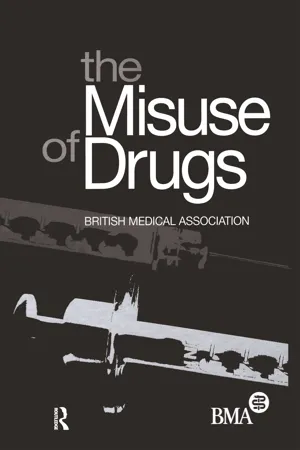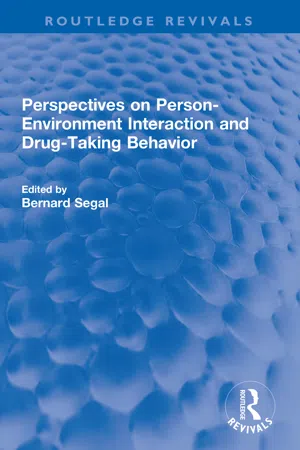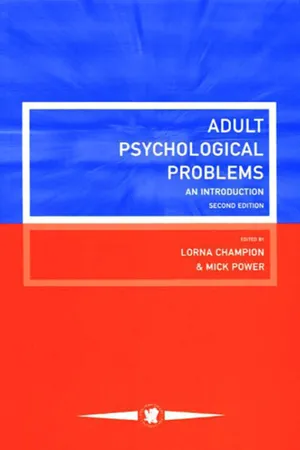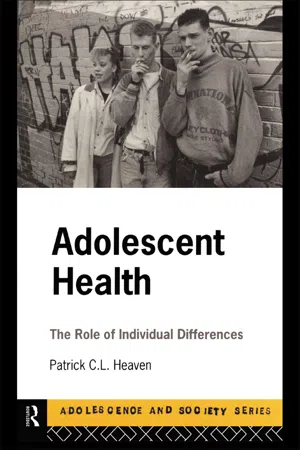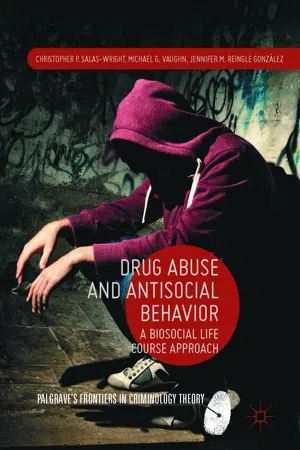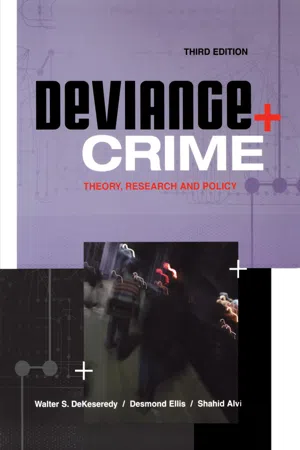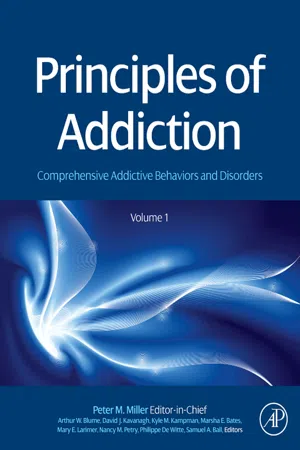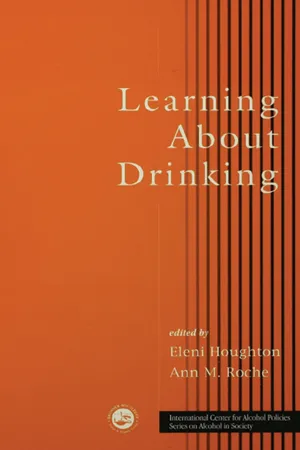Psychology
Influences on Drug Use
Influences on drug use encompass a range of factors that can impact an individual's decision to use drugs. These influences may include biological, psychological, social, and environmental factors. Biological influences can involve genetic predispositions, while psychological factors may include stress or mental health issues. Social and environmental influences can encompass peer pressure, cultural norms, and availability of drugs.
Written by Perlego with AI-assistance
Related key terms
Related key terms
1 of 4
Related key terms
1 of 3
12 Key excerpts on "Influences on Drug Use"
- eBook - ePub
- British Medical Association(Author)
- 2022(Publication Date)
- Routledge(Publisher)
10 One of the major difficulties in identifying the causes of and motives for drug use is that much of the research into Influences on Drug Use has to be — by its very nature — descriptive. Certain personality types, socio-economic situations and family structures are also coexistent with drug use. Whether one can be said to encourage or cause the other, however, remains unresolved.Personality and mental illness
One of the longest running debates in the drugs field is whether there is a relationship between an individual’s mental state and drug-taking, and whether the former can be said to cause the latter, the former is the result of the latter, or whether they are simply strongly associated. A recent Dutch study found that 9 in 10 polydrug users undergoing treatment could be ‘dual diagnosed’ for at least 1 personality disorder11 (‘dual diagnosis’ refers to the coexistence of substance use and 1 or more separate psychiatric disorder).12 Very little research, however, has been undertaken in the UK on this relationship. One of the few studies carried out, found that 55% of patients admitted to a psychiatric unit in the South-West of England had a history of drug or alcohol dependence and that serious violence was particularly associated with such dependence.13Studies have found that schizophrenic patients using drugs have an earlier onset of psychosis14 and their functioning is better than non-drug using schizophrenics prior to their illness. This has been interpreted as suggesting that drug use may have precipitated their psychotic illness but it could alternatively be the case that those in the acute stages of illness may have had a milder disorder which had been exacerbated by the substance misuse.15 - eBook - ePub
- Sandy Jackson, Luc Goossens, Sandy Jackson, Luc Goossens(Authors)
- 2020(Publication Date)
- Psychology Press(Publisher)
Finally, another interesting proposal is the model by Hawkins, Catalino and Miller (1992). This model is based on the assumption that the different risk factors that configure the biopsychosocial matrix do not occur independently or in isolation but frequently take place in combination, thus affecting different areas of the adolescent’s performance. Adolescents susceptible to highrisk behaviours show problems in multiple areas and tend to belong to social networks that foster the development of these risk behaviours and reinforce their continued performance (Hawkins et al., 2002). These authors consider it necessary to study the different risk factors that are present in substance consumption from an ecological perspective, which takes into account five basic contexts: individuals, school, family, peers, and community. In this respect, they consider laws and normative behaviours, availability of substances, economic deprivation, neighbourhood disorganization and mobility to be important risk factors for substance consumption in the societycommunity context. In the family context, organization, practices of family control, conflicts, and parental styles are also considered to be relevant risk factors. In the academic area, some significant factors are recurrent absenteeism, low academic performance, little connection with the school environment and the existence of persistent and early antisocial behaviours. In relation to the peer group, Hawkins et al. (1992, 2002) regard peer rejection (or indifference at elementary school), favourable attitudes to substance consumption as well as behaviours of substance use by peers to be facilitator factors of drug consumption. Finally, in an individual context, biological and cognitive factors, rebellion against normative attitudes and values of society, lack of coping abilities, and a precocious initiation in deviant behaviours are considered by these authors to be important predictors of substance consumption.4. Applying constructs from the biopsychosocial model to initiation and continued drug useIn accordance with the main contexts (individual, family, peer group and community) proposed in the biopsychological theories just mentioned, we will now try to integrate the different concepts and constructs on which these approaches are based in an explicative model that is focused on the risk factors associated to the different phases of drug consumption.As is shown in more detail in the following, while a considerable number of these risk factors concern the individual at different levels (biological, psychological, and socio-demographical), some refer to the influences of significant others (family and peers), and some refer to elements of a macro social order.4.1 The individual: Biological psychological, and structural variables 4.1.1 Biological variablesThe studies carried out in this field have shown that various drugs that produce an increase in a positive mood or euphoria, such as nicotine and alcohol, directly or indirectly affect the inhibiting neurotransmitter GABA, dopamine in the accubems nucleus or in the prefrontal cortex (Hodgkins et al., 2004; Tomkins & Sellers, 2001). The stimulation of these dopaminergic mechanisms represents the most important factor in explaining the strengthening effects and the potential addiction of various abusive substances. In addition to dopamine, it has been confirmed that certain proteins and other neurotransmitters contribute to the pathophysiology of the individual risk of drug dependency (Smith & Capps, 2005). - eBook - ePub
Alcohol, Other Drugs, and Behavior
Psychological Research Perspectives
- John R. Jung(Author)
- 2009(Publication Date)
- SAGE Publications, Inc(Publisher)
Now that we have considered the psychological and social context for licit drug use from a layperson’s perspective, we will describe major psychological theories of alcohol and other drug use as well as discuss the research evidence to evaluate their validity. These theories focus variously on physiological, affective, cognitive, and social psychological factors. There are some common factors underlying the initiation into use of alcohol, cigarettes, and coffee, and we will focus on these similarities, although the details of a complete theory for each drug will differ.Theories that focus on the role of pharmacological properties of drugs ignore the role of psychological variables such as the social and physical setting where a drug is used, personality and temperament differences, and the prevailing mood and motivation leading to drug use. Conversely, theories concerned with social and psychological factors discount pharmacological effects on neurophysiological processes that underlie the subjective experiences and behavioral consequences of drugs.Psychological theories are needed to understand what leads to initial drug use. After use begins, theories about pharmacological and neurophysiological processes become of increased value in explaining continued drug use, especially when it develops into drug abuse and dependence. Dependence may develop after long-term habitual drug use in which the user may no longer have conscious or volitional control over drug use that initially involved choice.Both types of theories are needed. They should be viewed as complementary rather than competing rivals. It may be useful to think of different types of theory as focusing on different aspects of drug use as well as on drug use during different points over time. No single theory can provide a complete understanding.Social Learning Theory
Social learning theory - Bernard Segal(Author)
- 2022(Publication Date)
- Routledge(Publisher)
Newcomb & Bentler, 1985 ). As noted earlier, general involvement with drugs typically declines during the third decade of life. Still, there is a degree of stability or consistency in the relative involvement with drugs; those most deeply involved as adolescents are most likely to be involved as young adults. Those who were most deeply involved and, to a degree, who “matured out” of excessive substance abuse tend to become involved in adult roles, particularly marriage or a committed relationship. Marijuana use tends to be seen as incompatible with adult family roles, and thus, in successful marriages, tends to cease around the time of marriage (males) or childbirth (females). In short, drug involvement may predict choices and changes in the psychosocial development of the person, and may change along with such transitions.DRUGS AND DRUG USE
It may strike the reader as rather strange that explanations of drug-using behaviour do not refer to the psychoactive properties of these drugs. In all of these models, psychopharmacological factors are implicit or ignored. And yet, it is well-established that chronic and excessive use of a drug can cause changes in physiological systems which mediate drug action, changes in the rate at which the drug is metabolized, and changes in what users experience when the drug is taken and when it is not taken. Current research on neurochemical receptors and endogenous substances which resemble opiate and benzodiazapine drugs suggests that these systems may well be altered by chronic excessive use (Weisz & Thompson, 1983 ).It must be noted, for example that DSM-III (1980) defines two types of substance use disorders: abuse, defined in terms of adverse consequences over a period of time of continued use, and dependence a more serious disorder defined in terms of tolerance and withdrawal. A recent psychiatric critique suggests merging these two categories, in part because physiological dependence is not equivalent or indicative of the experience of “being dependent,” and does not explain the compulsive character of addictive behaviour (Rounsaville, Spitzer & Williams, 1986- eBook - ePub
- Bernard Segal(Author)
- 2014(Publication Date)
- Routledge(Publisher)
Perspectives on Drug Use in the United States Louise G. Richards, Ph.D.ABSTRACT. Different views have prevailed within our society that have provided divergent approaches to explain drug use and drug addiction. Many of these approaches have involved medical, sociological and psychological perspectives; moral factors have also been evoked. This paper explores drug use from a different perspective—cultural anthropology. It discusses drug use as a natural result of human technology. Drawing on a theory of culture as communication systems derived from elaborate patterns of behavior, this paper proposes that criminal and medical explanations of drug abuse have inhibited the development of a comprehensive understanding of drug use. It is possible that a “new culture” has developed in which many people anticipate using some type of psychoactive substance, selected from the legal, illicit and prescribed substances, on an “as needed” basis to change mood or feeling-state. These thoughts are elaborated on in the present article.Drug use and addiction have existed under several different guiding policy assumptions: disregarded as personal eccentricity; labelled as a scourge on the society, especially the criminality and violence attributed to use; believed to be a disease that can be treated and perhaps cured. This paper will explore another conceptualization that may throw additional light on what seems to be an intractable problem. It is a framework derived from cultural anthropology: psychoactive substances as the natural result of human technology, their consumption patterns, and their spread through the population. Drawing on a theory of culture as communication systems derived from elaborate patterns of behavior (Hall, 1959), it is proposed that the criminal and medical conceptualizations have kept us in a defensive posture toward drug use. Consideration of abused drugs and others substances as part of the exploitation system of the society leads to new insights into the phenomenon. It is possible that a new “implicit culture” has developed in which a large share of the population expects to use some psychoactive substance, selected from among the legal, illicit and prescribed ones, on an “as needed” basis, to change mood or feeling-state. These thoughts are developed further in the sections that follow. - eBook - ePub
Adult Psychological Problems
An Introduction
- Lorna Champion, Michael Power(Authors)
- 2014(Publication Date)
- Taylor & Francis(Publisher)
There have been numerous hypotheses regarding the underlying causes of psychological dependence, with varying implications for treatment. On the one hand it has often been suggested that certain personality traits may be associated with proneness to addiction; as yet there is little convincing evidence that this is so. Other theories focus on particular drug effects that the individual experiences, and conceptualise psychological dependence as an inability to cope with the void that cessation of drug use would leave. Whereas psychoanalytic models may postulate that the drug serves crucial symbolic functions, cognitive-behavioural formulations emphasise very practical needs such as dealing with stress, or acceptance within a particular sub-culture. This theoretical framework will be discussed at greater length later.As it has been recognised that addiction to drugs is largely a psychological phenomenon, parallels have been drawn with other types of compulsive behaviour such as gambling or over-eating, and it is now common to hear the term “addiction” applied to these behavioural abnormalities; similarly, the word “workaholism” has been coined to describe what is perceived as pathological over-working. This terminology assumes that these superficially diverse behaviours are maladaptive responses to a range of underlying needs, excessive drug use representing just one example of such a general process.APPROACHES TO UNDERSTANDING AND TREATING ADDICTION
As is clear from the foregoing discussion, addiction is a complex and multifaceted disorder, and interventions are correspondingly diverse. Although a proportion of addicts either quit unaided, or seek help to do so because, for one reason or another, they have come to see their dependence as undesirable in itself, there is a substantial proportion who would prefer to carry on using drugs and do not consider drug use per se - eBook - ePub
Adolescent Health
The Role of Individual Differences
- Patrick Heaven(Author)
- 2002(Publication Date)
- Psychology Press(Publisher)
et al. 1987). Two factors were seen as important in predicting the initiation of cigarette smoking, namely risk-taking/ rebelliousness and perceived smoking prevalence. The authors noted that the extent to which significant others are perceived to smoke was an important predictor, together with risk-taking, in the decision to start smoking.A series of several detailed research studies by J.Brook and her colleagues (see Brook and Brook 1990) has uncovered several domains of variables that determine drug use. These domains are:- Childhood factors Child’s personality Family factors
- Parent personality and drug use Conventionality Control of emotion Parent drug use Intrapsychic functioning
- Marital harmony
- Adolescent personality Conventionality Control of emotion Sibling relations Inter-personal relatedness Intrapsychic functioning
- Parent-adolescent relations Mutual attachment
- Peer system
Huba and Bentler (1982) have also proposed a domain model of drug initiation and use. As with other domain approaches such as the one described above, they incorporate psychosocial factors into their model, yet go further by including genetic and biological considerations as well. They are of the view that biological, intra-personal, inter-personal, and sociocultural factors interact in explaining drug behaviour. They suggest that some domains might exert more influence on particular individuals, while other domains might be more important at particular stages of drug use.Brook and her colleagues have shown that peers have an important influence on the frequency and timing of drug use, whereas family and personality factors are more likely to determine the individual’s stage of drug use (Brook and Brook 1990). Thus, family and peer factors interact in determining drug use. It is argued that the family, in particular the teenager’s attachment to mother and father, acts as a protective factor which shields the adolescent from participation in the drug culture. By internalising parental norms and values, and by living in a family that is characterised by emotional warmth and in which the channels of communication between members are open, adolescents are less likely to be initiated into drug use. Teenagers who do not use drugs or alcohol are more likely to be on good terms with their parents. Very often drug use is found in homes where one parent is absent or in homes where marital separation has occurred (Green 1979). - eBook - ePub
Drug Abuse and Antisocial Behavior
A Biosocial Life Course Approach
- Christopher P. Salas-Wright, Michael G. Vaughn, Jennifer M. Reingle González(Authors)
- 2017(Publication Date)
- Palgrave Macmillan(Publisher)
2014 ). The list goes on and on as we have observed the manifold ways that social factors of all sorts help us make sense of who is and isn’t at heightened risk of addiction. Beyond the specifics, the takeaway here is that, while neurobiology is indispensable to a state-of-the-art understanding of addiction, there is simply no getting around the fact that drug abuse and addiction are phenomena that are also profoundly social in nature.Above we mentioned that some thinkers would likely suggest we situate our understanding of addicted brains within a broader social context. We should note that such thinking is not unique to ecological-systems theorists, but rather is an assertion that is also made by the leading proponents of the brain disease model of addiction. Leshner (1997 ) notes quite clearly in his seminal piece on addiction as a brain disease that “Addiction is not just a brain disease. It is a brain disease for which the social contexts in which it has both developed and is expressed are critically important” (p. 46). Similarly, McLellan et al. (2000 ), in their original article casting addiction as a chronic medical illness, unequivocally underscore the critical importance of factors such as socioeconomic status and social supports in the successful treatment of addiction and other chronic illnesses. Along the same lines, even a cursory review of the neurobiological model proposed by Volkow and Baler (2014 ) points to the foundational impact of factors in the economic, social, and built environment in influencing risk for drug use disorders. Simply, since its inception, leading theorists have continually recognized that the genetic and neurobiological understanding of addiction must be situated within a social, economic, and environmental context. In the words of Carter and Hall (2012 ),A major challenge for addiction policy and ethics will be finding ways to educate the public about the neurobiological basis of addiction in ways that recognize that drug use and addiction involves changes in the brain, but can still nevertheless be affected by individual and social choices, and the social environment (p. 249). - eBook - ePub
Angles Of Vision
How To Understand Social Problems
- Leonard Beeghley(Author)
- 2018(Publication Date)
- Routledge(Publisher)
6 DrugsOutline of Chapter 6
I. Dimensions of Drug Use A. Historical Dimensions 1. Alcohol 2. Tobacco 3. Marijuana 4. Cocaine 5. Heroin B. International Dimensions II. Consequences of Drug Abuse III. Individuals and Drug Use and Abuse A. Personal Experiences 1. Unemployment 2. Family Instability 3. School Performance 4. Peer Influence 5. Neighborhood Influence 6. Religiosity B. Personal Characteristics 1. Age 2. Social Class C. Poverty, Alienation, and Drug Abuse IV. Social Structure and Drug Use A. The Demand for Drugs 1. Societal Affluence 2. The Value Placed on Pleasure 3. The High Rate of Poverty B. The Supply of Drugs 1. Failure of Eradication Efforts 2. Economic Development in Producing Nations 3. Open Borders 4. The Limits of Law Enforcement V. Implications Drugs are used in every society because they make people feel "high," another (albeit artificial) way of feeling good. Drug use is especially "high" in the United States and other Western nations. But some drugs are illegal, which gives their use an aura of excitement and rebellion. And because they are illegal, they generate crime and violence, destroy neighborhoods, have inflated prices that attract people into the drug trade, preoccupy the police, and create clogged courts. These problems lead some observers to favor legalizing drugs because they believe the impact of prohibition is worse than the substances themselves.Yet drugs are often harmful. They damage the body, sometimes causing death, and can lead to loss of job, home, and marriage. So drugs often injure both users and their families. Eugene O'Neill portrays this process vividly in his play Long Day's Journey into Night, which describes the impact of his mother's ab use of heroin on her family (1962). Because of these effects, some see drugs as evil and favor laws prohibiting consumption. Drug use, they say, is like a slippery slope: It leads to drug dependence and abuse and demoralizes society.These different positions are not easily resolved. A story from Greek mythology illustrates the difficulties. The Sphinx was a monster with the face of a woman, the body of a lion, and the wings of a bird. In Sophocles' play Oedipus the King, - eBook - ePub
Deviance and Crime
Theory, Research and Policy
- Walter DeKeseredy, Desmond Ellis, Shahid Alvi(Authors)
- 2014(Publication Date)
- Routledge(Publisher)
In sum, feminist studies on women’s use of drugs have built a persuasive body of evidence indicating that their pathways, experiences, and exit strategies are different than those of men, and that these processes are deeply rooted in broader problems of sexism and patriarchy in modern societies, as well as class and race issues. As this evidence builds, it is critically important for policymakers, healthcare workers, and other practitioners to take women’s different experiences seriously.Summary
In this chapter we have examined empirical and theoretical aspects of drug use and abuse. After reading it, you should understand why it is important to use subjectivist definitions of “drugs.” In addition, we presented an overview of the levels of drug use in the United States, the kinds of drugs people use, and the characteristics of drugs and the people who use them. As we have noted in other chapters in this book, none of the theoretical explanations offered in this chapter are by themselves capable of explaining the multiple realities of drug use and abuse. Indeed, because this book focuses on the sociology of deviant and criminal behavior, we have not explored emerging research emphasizing the biological and psychological correlates of addiction, and how these are related to social settings and relationships.The theories explored here, however, do point to the centrality of social conditions such as poverty, deprivation, and gender relations in explaining drug use and abuse. Moreover, the chapter has attempted to show that the current drug war in America has not worked, and that the time to consider alternative strategies—perhaps one of “reducing the harm” caused by drug abuse—is long overdue. - eBook - ePub
Principles of Addiction
Comprehensive Addictive Behaviors and Disorders, Volume 1
- (Author)
- 2013(Publication Date)
- Academic Press(Publisher)
Iatrogenic effects present a challenge, but this challenge can be overcome. Although iatrogenic effects are significant, there is little evidence of these effects across research studies. Therefore, this effect is not as extensive as initially thought. Furthermore, iatrogenic effects can be constructively exploited, resulting in positive outcomes such as a decrease in problem behavior. Mixing prosocial and high-risk peers is an effective way of positively harnessing iatrogenic effects. Recent studies indicate that supportive peer involvement effectively reduces the problem behavior, especially for pairs of two people (dyads) rather than in a group setting. For example, the smoking cessation intervention would be more effective when pairing a smoker with a supportive nonsmoker, or pairing a heavy smoker with a light smoker.Summary
In summary, peer influences on addiction are central to the initiation of substance use and engagement in addictive behaviors. Peer influences seem to peak in adolescence and young adulthood. This is not to say that peers do not have a substantial influence later in life but the nature of peer relationships change considerably as emerging adults begin to transition into adult roles and responsibilities. Even when peer influences seem most evident earlier in the developmental course of life, they also seem more evident in the early developmental trajectory of addiction. Substance dependence typically includes nonsocial use and nonsocial motivations for use (e.g. tension reduction and withdrawal avoidance).Peer influence is embedded within the larger context of social influences. A broad review of social influence theories suggests several common themes. Social influences can be explicit but they are often implicit and based on our imperfect beliefs about others’ expectations of us. Moreover, others’ expectations do not influence us, but rather our beliefs about others’ expectations, and these are often quite inaccurate. Another common theme is that the degree of influence that others have on our behavior depends on how much we care about or identify with them. People whom we care nothing about are less likely to influence us than those with whom we closely identify. A third theme is that what is viewed as good and bad is relative to the social group. Being able to drink large quantities of alcohol is good for some and not good for others. Finally, social influences are often governed by social consequences. We observe how people respond to our own and others’ behaviors and those responses accordingly increase or decrease the likelihood of future behaviors. - eBook - ePub
- Eleni Houghton, Anne M. Roche(Authors)
- 2013(Publication Date)
- Routledge(Publisher)
In the paradigm presented by Green and Kreuter, the reinforcing factors are usually the factors least explored. This is partly because reinforcement typically comes from people other than the person of interest, i.e., the adolescent. Reinforcement is also implicit in predisposing and enabling factors. Predisposing knowledge, attitudes, and values are often reinforced by other people. Similarly, factors that enable a behavior implicitly reinforce it. For example, easy access to alcohol reinforces its continued consumption. Evidence of a tendency to overlook reinforcing factors is seen in education’s tendency, at least in health-related issues, to focus on “curing the ill” rather than supporting and encouraging the “well.” Similarly, society fixates on the problematic aspects of a health issue, e.g., on binge drinking, to the exclusion of understanding low-risk, responsible, and legal alcohol use better.Family and Peer Influences Family and peer influences could be viewed as strongly predisposing factors, but they are also examples of reinforcing influences.Lerner (1993) has pointed out that any behavior has to be seen in the larger context of family, community, peers, neighborhood, workplace, and school. Family and peer influences are discussed in detail elsewhere in this volume, but it is important to acknowledge their role in the reinforcement of many other influences. The family has the longest term, and perhaps the most pervasive, influence on the majority of young people and it is the peer group which often competes with this influence. Research in this area indicates that parental and sibling substance use increases the likelihood of adolescent use (McDermott, 1984); that inconsistent parental discipline and low parental aspirations for children predict early and more frequent use of alcohol and other substances (Kandel & Andrews, 1987); and that family conflicts, marital discord, and low family bonding are associated with delinquency and increased alcohol and drug use (Brook, Brook, Gordon, Whiteman, & Cohen, 1990).In an analysis of data from approximately 90,000 students in 80 U.S. schools, Blum & Rinehart (undated) conclude that alcohol use among young people is related to parental and family connectedness. Connectedness is not necessarily related to the presence or absence of parents in the house, but to a sense of caring and satisfaction with parental relationships and to a feeling of being wanted and paid attention to by the other family members—even if one or both parents were not present.
Index pages curate the most relevant extracts from our library of academic textbooks. They’ve been created using an in-house natural language model (NLM), each adding context and meaning to key research topics.
Explore more topic indexes
Explore more topic indexes
1 of 6
Explore more topic indexes
1 of 4
